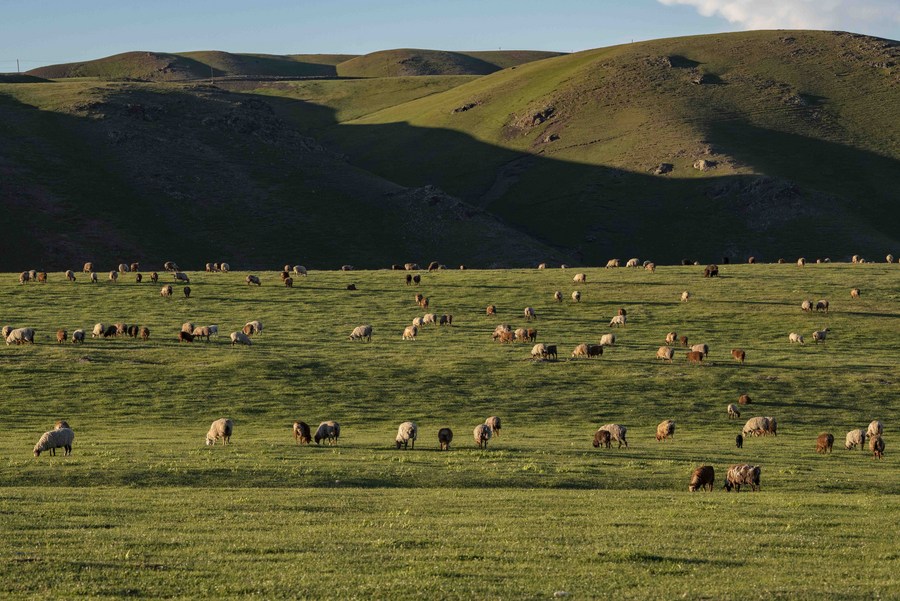Multiple localities across China yield results in vigorously carrying out grassland protection and restoration projects
In 2021, China planted 6.67 million hectares of forests and grassland, including 3.07 million hectares of grassland that were further improved by way of efforts to expand their grass cover, according to a bulletin on afforestation in China during 2021 as recently released by the National Greening Commission.

Photo taken on June 15, 2021 shows the view of herds at the summer pasture on the Barlik Mountain in Yumin county, northwest China's Xinjiang Uygur Autonomous Region. (Xinhua/Hu Huhu)
In recent years, various localities in the country have carried out the protection and restoration of grasslands in a continuous manner, having built beautiful grasslands through their own unique endeavors.
Maodeng Ranch, located in Xilinhot city, north China’s Inner Mongolia Autonomous Region, was once severely degraded. To recover the grassland’s ecosystem, the ranch relocated herders from those places encountering severe grassland degradation to a newly-built village and encouraged them to get involved in cow breeding. As a result of this, 400,000 mu (26,666.67 hectares) of grassland, or half of the total area of the ranch, was enclosed for better protection and was later built into an ecological protection area.
Between 2003 and 2021, protective reaping of the grass was allowed only during the autumn season within the bounds of the protection area. Some of the forage grass planted within the protected area was sold to employees at the ranch and their children at a price much lower than the market price, while the rest of the grass was sold on the market, with the earnings from the grass being used to maintain the operations of the ranch.
Currently, the grass coverage rate inside the protected area has reached 62 percent from less than 40 percent in the past, while the average height of the grass is nearly 40 centimeters, compared with about 10 centimeters in the past, with the average yield of grass per mu having increased to 40 kilograms from 15 kilograms.
The protected area not only helped restore the grassland’s ecosystem, but also delivered economic benefits to local residents, said Yang Hai, head of the ranch. In the autumn of 2021, local herder Chen Caiyun bought 15 tonnes of high-quality forage grass from the ranch, which was priced at 800 yuan per tonne. In total, the forage grass cost 6,000 yuan less than what it would have cost on the market.
In 2020, the National Forestry and Grassland Administration of China kicked off the country’s first pilot program to construct grassland nature parks in the country. “As one of the first pilot grassland nature parks, the Maodeng national grassland nature park seeks to preserve the grassland ecosystem of the wider Xilingol Grassland and rare plants and animals, vigorously advance grasslands protection and restoration projects, and properly develop the local grass industry and ecotourism by making use of its grassland scenery and cultural resources,” Yang introduced.
The Fenglongshan Grassland in Xundian Hui and Yi Autonomous County in Kunming, southwest China’s Yunnan Province has also achieved amazing results in grassland protection in recent years.
Excessive grazing, once a problem faced by the grassland, has been gradually resolved as the locality has constantly ramped up protection efforts in recent years, introduced Yin Caineng, an official from the provincial forestry and grassland bureau of Yunnan.
Shi Yixue, a farmer from Fenglongshan village, Xundian Hui and Yi Autonomous County, has been a forest ranger for the course of more than 20 years. Before 2015, Shi rode a motorcycle to the forest to carry out protection activities.
“Those who visited the Fenglongshan Mountain were mainly local residents,” Shi said. As the local road conditions became better and after paved roads were built in the locality, Shi bought a car to more conveniently patrol the forest. Meanwhile, the mountain has become a destination for an increasing number of tourists from outside the locality. “What attracts the tourists is the unique grassland scenery of southern China,” said Shi.
Statistics show that the total area of grassland in Yunnan has reached 229 million mu (15.27 million hectares). Being home to various grassland plants that can be categorized into 199 families, 1,404 types and 4,958 species, Yunnan is one of the provinces in China that has the most diversified varieties of grassland and plants.
Photos
Related Stories
- Winter scenery of Haltent grassland in Gansu, NW China
- Tibetan college graduate returns to hometown to take on task of greening, restoring grassland
- Over 7 bln USD pooled to support grassland restoration in China's Inner Mongolia
- China to restore 15.3 million hectares of degraded grassland
- Summer landscape of Chenbarhu Banner Grassland in Inner Mongolia
- Scenery of grassland in Saibei management district of Zhangjiakou, Hebei
- Scenery of grassland in Xilin Gol in Inner Mongolia
- Scenery of Xilingol Grassland in Inner Mongolia
- Once-dwindling freshwater lake on grassland regains vitality
- China sees improvements in grassland ecology
Copyright © 2022 People's Daily Online. All Rights Reserved.










